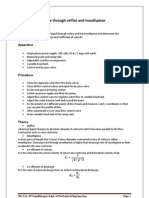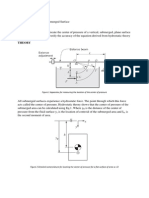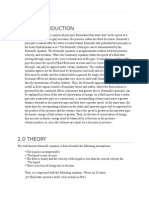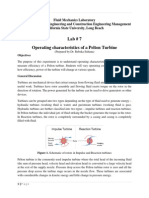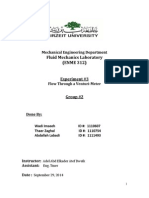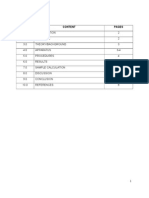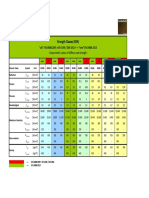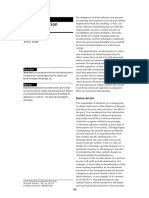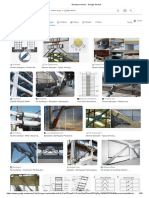100%(1)100% found this document useful (1 vote)
687 viewsCC501 - Lab - 1 Hydraulic
CC501 - Lab - 1 Hydraulic
Uploaded by
Muhammad Azizul1. This document describes an experiment to determine the magnitude and point of application of hydrostatic forces on plane surfaces.
2. The objectives are to experimentally determine the magnitude of hydrostatic pressure forces, the center of pressure, and resultant forces on plane surfaces, and to compare the experimental results with theoretical values.
3. The apparatus used includes a hydrostatic force apparatus with a water vessel, dentent, slider, stop pin, water level scale, rider, weights, and handles. Procedures are provided to experimentally evaluate the center of pressure with the water vessel in vertical and tilted positions.
Copyright:
© All Rights Reserved
Available Formats
Download as PDF, TXT or read online from Scribd
CC501 - Lab - 1 Hydraulic
CC501 - Lab - 1 Hydraulic
Uploaded by
Muhammad Azizul100%(1)100% found this document useful (1 vote)
687 views11 pages1. This document describes an experiment to determine the magnitude and point of application of hydrostatic forces on plane surfaces.
2. The objectives are to experimentally determine the magnitude of hydrostatic pressure forces, the center of pressure, and resultant forces on plane surfaces, and to compare the experimental results with theoretical values.
3. The apparatus used includes a hydrostatic force apparatus with a water vessel, dentent, slider, stop pin, water level scale, rider, weights, and handles. Procedures are provided to experimentally evaluate the center of pressure with the water vessel in vertical and tilted positions.
Original Description:
JABATAN KEJURUTERAAN AWAM , SULTAN AZLAN SHAH
Original Title
CC501_LAB_1 HYDRAULIC
Copyright
© © All Rights Reserved
Available Formats
PDF, TXT or read online from Scribd
Share this document
Did you find this document useful?
Is this content inappropriate?
1. This document describes an experiment to determine the magnitude and point of application of hydrostatic forces on plane surfaces.
2. The objectives are to experimentally determine the magnitude of hydrostatic pressure forces, the center of pressure, and resultant forces on plane surfaces, and to compare the experimental results with theoretical values.
3. The apparatus used includes a hydrostatic force apparatus with a water vessel, dentent, slider, stop pin, water level scale, rider, weights, and handles. Procedures are provided to experimentally evaluate the center of pressure with the water vessel in vertical and tilted positions.
Copyright:
© All Rights Reserved
Available Formats
Download as PDF, TXT or read online from Scribd
Download as pdf or txt
100%(1)100% found this document useful (1 vote)
687 views11 pagesCC501 - Lab - 1 Hydraulic
CC501 - Lab - 1 Hydraulic
Uploaded by
Muhammad Azizul1. This document describes an experiment to determine the magnitude and point of application of hydrostatic forces on plane surfaces.
2. The objectives are to experimentally determine the magnitude of hydrostatic pressure forces, the center of pressure, and resultant forces on plane surfaces, and to compare the experimental results with theoretical values.
3. The apparatus used includes a hydrostatic force apparatus with a water vessel, dentent, slider, stop pin, water level scale, rider, weights, and handles. Procedures are provided to experimentally evaluate the center of pressure with the water vessel in vertical and tilted positions.
Copyright:
© All Rights Reserved
Available Formats
Download as PDF, TXT or read online from Scribd
Download as pdf or txt
You are on page 1of 11
HYDRAULIC LABORATORY
CIVIL ENGINEERING DEPARTMENT
POLYTECHNIC SULTAN AZLAN SHAH
EXPERIMENT : 1
TITLE : HYDROSTATIC FORCE EXPERIMENT
OBJECTIVES : 1. To determine experimentally the magnitude of the force of
pressure, its point of action (center of pressure) and the
resultant force a plane surface.
2. To compare the experimental result with the theoretical values
APPARATUS : Hydrostatic force apparatus HM 150.05
1.Water vessel
2.Dentent
3.Slider
4.Stop pin
5.Water level scale
6.Rider
7.Weights
8.Handles
HYDRAULIC LABORATORY
CIVIL ENGINEERING DEPARTMENT
POLYTECHNIC SULTAN AZLAN SHAH
EXPERIMENT : 1
TITLE : HYDROSTATIC FORCE EXPERIMENT
OBJECTIVES : 1. To determine experimentally the magnitude of the force of
pressure, its point of action (center of pressure) and the
resultant force a plane surface.
2. To compare the experimental result with the theoretical values
APPARATUS : Hydrostatic force apparatus HM 150.05
1.Water vessel
2.Dentent
3.Slider
4.Stop pin
5.Water level scale
6.Rider
7.Weights
8.Handles
HYDRAULIC LABORATORY
CIVIL ENGINEERING DEPARTMENT
POLYTECHNIC SULTAN AZLAN SHAH
EXPERIMENT : 1
TITLE : HYDROSTATIC FORCE EXPERIMENT
OBJECTIVES : 1. To determine experimentally the magnitude of the force of
pressure, its point of action (center of pressure) and the
resultant force a plane surface.
2. To compare the experimental result with the theoretical values
APPARATUS : Hydrostatic force apparatus HM 150.05
1.Water vessel
2.Dentent
3.Slider
4.Stop pin
5.Water level scale
6.Rider
7.Weights
8.Handles
THEORY
Centre of Pressure
The hydrostatic pressure of liquid is the gravitational pressure P
hyd.
It rises due to the
intrinsic weight as the depth t increases, and is calculated from:
P
hyd
= .g.t
Density of water,
g Acceleration due to gravity (g=9.81 m/s
2
),
t Distance from liquid surface
A linear pressure profile is acting on the active surface shown
in Fig. 1.1, because the hydrostatic pressure rises proportional
to the depth t. The resultant force F
p
is therefore not applied at the centre of force C of the active
surface, but always slightly below it, at the so-called centre of pressure D.
Resultant Force
The hydrostatic pressure acting on the active surface can be represented as resultant force
F
p
, of which the line of application leads through the centre of pressure D. the size of this
resultant force corresponds to the hydrostatic pressure at the planar centre of force C of the active
surface:
P
c
= .g.t
c
P
c
Hydrostatic pressure at the planar centre of force
of the active surface
t
c
Vertical distance of the planar centre of force from
the surface of the liquid
If the wall is tilted by an angle :
P
c
= .g.cos .
The resultant force F
p
can now be calculated: F = p . A
PROCEDURE
Case 1 : Center Of Pressure With Vertical Positioning Of The Water Vessel (=0
o
)
1. Set the water vessel (1) to an angle of =0
0
using the detent (2) as shown.
2. Counterbalance the unit with a rotating slider (3): The stop pin (4) must be precisely in the
middle of the hole for this.
3. Mount the rider (6), set the lever arm on the scale (e.g. l=150mm).
4. Top up with water until the unit is balanced (stop pin (4) at centre of hole).
5. Read off water level s and enter it in the prepared worksheet.
6. Increase the appended weights (7) in increments of 0.5 1N and repeat the measurement.
Case 2 : Center Of Pressure With Water Vessel Tilted (0
o
< <90
o
)
1. Set an angle
0
and counterbalance the water vessel as described under experiment 1.
2. Enter the characteristic values in the prepared worksheet: Lowest water level s
t
and highest
water level s
h
of the active surface.
3. Set the water vessel (1) to an angle of
0
using the detent (2) as shown in case 1.
4. Counterbalance the unit with a rotating slider (3): The stop pin (4) must be precisely in the
middle of the hole for this.
5. Mount the rider (6), set the lever arm on the scale (e.g. l=150mm).
6. Top up with water until the unit is balanced (stop pin (4) at centre of hole).
7. Read off water level s and enter it in the prepared worksheet.
8. Increase the appended weights (7) in increments of 0.5 1N and repeat the measurement.
DATA COLLECTION
Case 1
Angle (
o
) = _________
Lowest water level (mm) = _______________
Highest water level (mm) = _______________
Lever arm, I (mm) Appended weight , F
G
(N) Water level reading, s (mm)
Case 2
Angle (
o
) = _________
Lowest water level (mm) = _______________
Highest water level (mm) = _______________
Lever arm, I (mm) Appended weight , F
G
(N) Water level reading, s (mm)
ANALYSIS AND DATA CALCULATION
1. Calculate the resultant force and calculated lever arm.
2. Check the result with the balance of moments.
Angle (
o
) = _________
Lever arm, I
(mm)
Appended weight ,
F
G
(N)
Calculated lever
arm, I
D
(mm)
Resultant Force,
F
P
(N)
Angle (
o
) = _________
Lever arm, I
(mm)
Appended weight ,
F
G
(N)
Calculated lever
arm, I
D
(mm)
Resultant Force,
F
P
(N)
Appendix 1 ( Hydrostatic Force Experiment)
Case 1 : Center Of Pressure With Vertical Positioning Of The Water Vessel (=0
o
)
A. Evaluating the experiment
Measured values:
s - water level reading
I - lever arm of the force due to weight
F
G
- force due to weight of the appended weight
B. Determining the centre of pressure
At a water level s, below the 100mm mark, the height of the active surface changes with the
water level. If the water level is above that mark, the height of the active surface is always
100mm.
Meaning:
s- water level
e distance of centre of pressure D from planar centre of force C of the active surface
I
D
distance to centre of motion of the unit
For a water level s < 100mm(pressure has a triangular profile):
=
1
6
= 200
1
3
Appendix 2 ( Hydrostatic Force Experiment)
For a water level s > 100mm(pressure has a trapezoidal profile):
=
1
12
(100 )
50
= 200 +
C. Determining the resultant force
The resultant force corresponds to the hydrostatic pressure at the planar centre of force C of
the active surface. Thus, the height of water level s must again be differentiated:
Meaning:
A
act
superficial content of active surface
b = 75mm width of liquid vessel
p
c
hydrostat pressure at planar centre of force
F
p
resultant force for hydrostat. Pressure on active surface
For s < 100mm (triangular profile):
=
2
= .
For s > 100mm (trapezoidal profile):
= ( 50 ) = 100 .
Appendix 3 ( Hydrostatic Force Experiment)
The resultant force is produced as
= .
D. Balance of moments
Calculated variables:
F
G
Appended weight
I lever arm of appended weight referred to centre of motion O
To check the theory, a balance of moments around the centre of motion O can be established
and checked:
Mo = 0: F
G
.I = F
P
.I
D
Case 2 : Center Of Pressure With Water Vessel Tilted (0
o
< <90
o
)
A. Evaluating the experiment
The difference between evaluation of the tilted vessel and that of the vertical vessel lies in the
translation of the water levels onto the tilted active surface: A factor cos
0
must be taken into
account here.
B. Determining the centre of pressure
When the water vessel is at a tilt, too, a triangular pressure profile is produced when the
water level is below s
h
; above that level a trapezoidal profile is produced.
Appendix 4 ( Hydrostatic Force Experiment)
Measured values:
s - water level reading
tilt angle of vessel
Meaning:
s
t
water level at lowest point of vessel
s
h
water level of active surface at rim
e position of centre of pressure
h height of active surface
I
D
distance between centre of pressure / centre of motion
For a water level s<s
h
a triangular profile as follows applies:
=
=
1
6
= 200
1
3
For a water level s>s
h
a trapezoidal profile as follows applies:
Appendix 5 ( Hydrostatic Force Experiment)
=
1
12
(100 )
50
= 150 +
C. Determining the resultant force
Meaning:
A
act
superficial content of active surface
b = 75mm width of liquid vessel
p
c
hydrostat pressure at planar centre of force
F
p
resultant force for hydrostat. Pressure on active surface
For s < s
h
with h:
=
2
= .
For s > s
h
(trapezoidal profile):
= ( 50 . ) = 100 .
The resultant force is produced as:
= .
D. Balance of moments
Calculated variables:
F
G
Appended weight
I lever arm of appended weight referred to centre of motion O
To check the theory, a balance of moments around the centre of motion O can be established
and checked:
Mo = 0: F
G
.I = F
P
.I
D
You might also like
- Volume of Nitrogen Required For Testing & Purging ContainersDocument2 pagesVolume of Nitrogen Required For Testing & Purging ContainersHgagselim SelimNo ratings yet
- Experiment 1 Hydrostatic Force and Center of Pressure: Lecturer: T.ADocument17 pagesExperiment 1 Hydrostatic Force and Center of Pressure: Lecturer: T.AeidalinNo ratings yet
- Hydraulic Lab ReportDocument18 pagesHydraulic Lab ReportMohd ShahrizanNo ratings yet
- ORIFICE DISCHARGE Lab Report SampleDocument9 pagesORIFICE DISCHARGE Lab Report SampleArjun Mullu50% (14)
- Duhok Polytechnic University Technical College of Engineering Petrochemical Department Transport Phenomena Fourth Year-2018-2019Document10 pagesDuhok Polytechnic University Technical College of Engineering Petrochemical Department Transport Phenomena Fourth Year-2018-2019Bryar XalilNo ratings yet
- Lab Report For Venturi MeterDocument9 pagesLab Report For Venturi MeterFirzana AmiraNo ratings yet
- Hydrostatic Force On A Plane Surface-8Document2 pagesHydrostatic Force On A Plane Surface-8Fahad AreebNo ratings yet
- Experiment 5 Flow Over Broad Crested WeirDocument5 pagesExperiment 5 Flow Over Broad Crested WeirKelly Obrien75% (4)
- Lab Manual-Manomety Lab Experiment PDFDocument12 pagesLab Manual-Manomety Lab Experiment PDFcheeball100% (1)
- Fluid Mechanics - Impact of Jet Vanes - ExperimentDocument4 pagesFluid Mechanics - Impact of Jet Vanes - ExperimentRavi Agarwal96% (24)
- Lab 2-Venturi MeterDocument4 pagesLab 2-Venturi MeterNor C-lah67% (3)
- EXP 5 - Study of Hydraulic Jump in A Rectangular ChannelDocument9 pagesEXP 5 - Study of Hydraulic Jump in A Rectangular Channelsiva ramNo ratings yet
- Experiment1 Orifice and Jet Flow Group1 A03Document6 pagesExperiment1 Orifice and Jet Flow Group1 A03Francis Aeron PabalanNo ratings yet
- Hydrostatic Pressure Apparatus: Instruction Manual & Experiment GuideDocument12 pagesHydrostatic Pressure Apparatus: Instruction Manual & Experiment GuideAbdullahJavedNo ratings yet
- Electric Submersible Pump BasicsDocument146 pagesElectric Submersible Pump BasicsAbhoe Stank100% (6)
- Hydrostatic Pressure LabDocument12 pagesHydrostatic Pressure LabMuhammadShah100% (1)
- AbstractDocument9 pagesAbstractEssam Ahmed Abd MeguidNo ratings yet
- Swinburne University of Technology: School of Engineering (Sarawak Campus)Document19 pagesSwinburne University of Technology: School of Engineering (Sarawak Campus)Mahfuzah MustaphaNo ratings yet
- Hydrostatic Pressure - Fluid-Mechanics-Lab-Manual-15-23Document9 pagesHydrostatic Pressure - Fluid-Mechanics-Lab-Manual-15-23Yasir A. Al-ShataifNo ratings yet
- Flow Through An OrificeDocument6 pagesFlow Through An Orificehozipek559950% (2)
- LAB REPORT - Discharge Over WeirsDocument9 pagesLAB REPORT - Discharge Over WeirsLuli LolNo ratings yet
- Experiment 1: Flow Over A NotchDocument15 pagesExperiment 1: Flow Over A NotchLai YenNo ratings yet
- Hydrostatic Pressure LabDocument8 pagesHydrostatic Pressure Labapi-307743354No ratings yet
- Orfice Free Jet FlowDocument17 pagesOrfice Free Jet Flowshekhynahcurtis80% (5)
- Lab - #1. - Flow Through Orifice PDFDocument6 pagesLab - #1. - Flow Through Orifice PDFCarlos J. Santacruz100% (1)
- Impact of JetDocument5 pagesImpact of Jetميسرة33% (3)
- Hydraulic Jump ExperimentDocument5 pagesHydraulic Jump Experiment1man1book50% (2)
- Weir Experiments.02Document14 pagesWeir Experiments.02alex100% (2)
- Manning's Roughness Coefficient (N)Document11 pagesManning's Roughness Coefficient (N)Khurram MumtazNo ratings yet
- Report of Pipe NetworksDocument17 pagesReport of Pipe NetworksJuan Manuel Sanabria GuioNo ratings yet
- Experiment To Determine The Centre of Pressure On A Partially Submerged Plane SurfaceDocument3 pagesExperiment To Determine The Centre of Pressure On A Partially Submerged Plane SurfaceUditha Wedage67% (3)
- WRE 212 - EXP 5 Flow Through External Cylindrical MouthpieceDocument7 pagesWRE 212 - EXP 5 Flow Through External Cylindrical MouthpieceAshik AshikNo ratings yet
- Flow Demonstration ExperimentDocument5 pagesFlow Demonstration ExperimentVictoria SooknananNo ratings yet
- Pipe Friction ExperimentDocument10 pagesPipe Friction ExperimentCstiosen50% (2)
- Flow Through Orifice and MouthpieceDocument5 pagesFlow Through Orifice and MouthpieceVrushiket Patil78% (9)
- Orifice & Free Jet FlowDocument6 pagesOrifice & Free Jet FlowMohamedElkikiNo ratings yet
- Lab Report 123Document9 pagesLab Report 123Falcon Tech0% (1)
- Flowmeter DEMONSTRATIONDocument20 pagesFlowmeter DEMONSTRATIONAfiq IkhwanNo ratings yet
- Hydrostatic ForceDocument6 pagesHydrostatic ForceAhmad MuzakkirNo ratings yet
- Calibration of Bourdon Pressure Gage PDFDocument3 pagesCalibration of Bourdon Pressure Gage PDFMohammed Cardoza100% (1)
- Demonstration On Bernoulli's TheoremDocument22 pagesDemonstration On Bernoulli's TheoremMahe RukhNo ratings yet
- Impact of A JetDocument11 pagesImpact of A JetMuhammad Hakim Jaffar0% (1)
- X5 FlowThroughAnOrifice BautistaDerwinDanielCDocument16 pagesX5 FlowThroughAnOrifice BautistaDerwinDanielCNadine Pascual100% (1)
- Free N Forced Vortex ReportDocument18 pagesFree N Forced Vortex ReportAuza100% (1)
- Lab-2: Flow Over A Weir Objectives: Water Resources Engineering Jagadish Torlapati, PHD Spring 2017Document4 pagesLab-2: Flow Over A Weir Objectives: Water Resources Engineering Jagadish Torlapati, PHD Spring 2017Katy PerryNo ratings yet
- Full Report Bernoulli Experiment TiqaDocument19 pagesFull Report Bernoulli Experiment TiqaAtiqah Samad100% (5)
- Fluid Mechanics Report.Document17 pagesFluid Mechanics Report.e'mir danielNo ratings yet
- 1 Rectangular NotchDocument4 pages1 Rectangular NotchAshlin Augusty80% (5)
- Lab Report Hydrostatic Pressure On Plane SurfaceDocument18 pagesLab Report Hydrostatic Pressure On Plane SurfaceAnis Thuraiya100% (1)
- Lab7-Phelton Turbine Experiment-UpdatedDocument7 pagesLab7-Phelton Turbine Experiment-Updatedtomtoms92No ratings yet
- Bernoulli's PrincipleDocument8 pagesBernoulli's PrincipleMD Atiqur Rahman Faisal100% (1)
- Slump Test of Portland Cement ConcreteDocument3 pagesSlump Test of Portland Cement ConcreteKevin P MendozaNo ratings yet
- Fluid Mechanics 2 - Practical 1 Discharge Through An OrificeDocument13 pagesFluid Mechanics 2 - Practical 1 Discharge Through An OrificeShivesh Sohawan50% (4)
- ReportDocument13 pagesReportZack Nel50% (6)
- Determination of The Liquid LimitDocument5 pagesDetermination of The Liquid LimitThabo ChuchuNo ratings yet
- BUOYANCY & FLOTATION - METACENTRIC HEIGHT ReportDocument8 pagesBUOYANCY & FLOTATION - METACENTRIC HEIGHT Reportميسرة94% (18)
- Venturi MeterDocument10 pagesVenturi MeterThaerZãghal100% (6)
- Hydro Lic Report Dka 4 BDocument13 pagesHydro Lic Report Dka 4 BshahrolhazrienNo ratings yet
- Hydrostatic Pressure TestDocument9 pagesHydrostatic Pressure TestshahrolhazrienNo ratings yet
- بلا عنوانDocument13 pagesبلا عنوانdes33uqNo ratings yet
- Lab1 Fluid ManualDocument10 pagesLab1 Fluid Manualjin76No ratings yet
- University Tenaga Nasional College of Engineering Department of Civil EngineeringDocument16 pagesUniversity Tenaga Nasional College of Engineering Department of Civil EngineeringMuhammad Zulhusni Che RazaliNo ratings yet
- The Basics of Desiel Engine and Diesel FuelDocument43 pagesThe Basics of Desiel Engine and Diesel FuelAnonymous JgZzTI0iNo ratings yet
- Girder Bridge Design ExampleDocument16 pagesGirder Bridge Design ExampleIyœ Møsisæ100% (1)
- Channeline BrochureDocument32 pagesChanneline BrochureAlexandru IgnatNo ratings yet
- Strength Classes (BSH) : EN14080:2005 + EN 1194 / DIN 1052 "New" EN 14080:2013Document1 pageStrength Classes (BSH) : EN14080:2005 + EN 1194 / DIN 1052 "New" EN 14080:2013Melo PereiraNo ratings yet
- MHT CET IMP FormulaDocument282 pagesMHT CET IMP FormulaklmbrthrsNo ratings yet
- Engine VibrationDocument3 pagesEngine VibrationИлларион ПанасенкоNo ratings yet
- Repair of Damage With Exposed Steel ReinforcementDocument4 pagesRepair of Damage With Exposed Steel ReinforcementMohamed NkNo ratings yet
- Thermal Physics Important NumericalsDocument1 pageThermal Physics Important NumericalsMehboob KhanNo ratings yet
- Chemistry: Delhi Public School Ruby Park, Kolkata Class - XIDocument3 pagesChemistry: Delhi Public School Ruby Park, Kolkata Class - XIAb CdNo ratings yet
- Mec616 Exam 2005Document4 pagesMec616 Exam 2005api-409876No ratings yet
- Kora KoraDocument8 pagesKora Korayorry25No ratings yet
- Letters: Biasing Reaction Pathways With Mechanical ForceDocument5 pagesLetters: Biasing Reaction Pathways With Mechanical ForceSutanwi LahiriNo ratings yet
- DNVGL RP C104Document103 pagesDNVGL RP C104KenginNo ratings yet
- Technical Data Manual: Vitocell 300-H EHA SeriesDocument16 pagesTechnical Data Manual: Vitocell 300-H EHA SeriesLaith MahmoudNo ratings yet
- Globalno ZatopljenjeDocument10 pagesGlobalno ZatopljenjeEna BrkicNo ratings yet
- Ijems 22 (3) 283-287Document5 pagesIjems 22 (3) 283-287Ankur gaurNo ratings yet
- تهویه تونلی و محاسباتDocument47 pagesتهویه تونلی و محاسباتMajid RoshaniNo ratings yet
- TFS Assets LED Brochures Expert PH Expert CTS Testers EXPERTPHCTS enDocument12 pagesTFS Assets LED Brochures Expert PH Expert CTS Testers EXPERTPHCTS enLuis TapiaNo ratings yet
- Conservation of Energy Work Power 2016 Ap WeeblyDocument34 pagesConservation of Energy Work Power 2016 Ap Weeblyapi-263675263No ratings yet
- 02 K Charts - AE+SIDocument1 page02 K Charts - AE+SILalang Dwiyoga SaktiNo ratings yet
- RAP 07 Fluids HW KeyDocument7 pagesRAP 07 Fluids HW KeyChandrea WillardNo ratings yet
- IRJET Review On Structural Behaviour ofDocument4 pagesIRJET Review On Structural Behaviour ofAdnan NajemNo ratings yet
- 535 1 NLSC Sample 24 GuideDocument6 pages535 1 NLSC Sample 24 Guidekyeyuneyasin572100% (2)
- Damper seismic - مخمدات الزلازل تقليل الانتقال- د. يوسف حميضةDocument26 pagesDamper seismic - مخمدات الزلازل تقليل الانتقال- د. يوسف حميضةDrYoussefHammidaNo ratings yet
- Previous Year Paper Physics Class 12Document12 pagesPrevious Year Paper Physics Class 12namanfbi18No ratings yet
- Nanomedicine and Nanotechnology in Ayurvedic Pharmaceutics An OverviewDocument4 pagesNanomedicine and Nanotechnology in Ayurvedic Pharmaceutics An OverviewEditor IJTSRDNo ratings yet
- Electrochemical CellsDocument63 pagesElectrochemical CellsHoongNo ratings yet
- Ncert 11 Part A Practice Paper PhysicsDocument16 pagesNcert 11 Part A Practice Paper Physicskavyamanchanda102No ratings yet


































